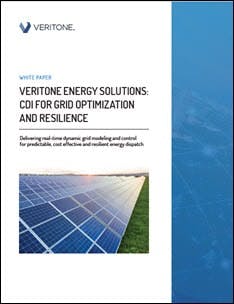A new white paper from Veritone explains how Cooperative Distributed Inferencing (CDI) technology delivers cost-effective resilience and grid optimization through real-time dynamic grid modeling.
Today’s electrical grids are dynamic and unpredictable. Extreme weather, natural disasters, fluctuating power and unpredictable green energy sources have led to higher energy costs and a grid that can no longer provide uninterrupted power. In its new report, Veritone shows how CDI “self-learns and adapts to ensure all energy devices in a microgrid, such as solar and battery power, deliver optimal energy at peak demand times and continue to operate autonomously if isolated from the main grid due to extreme weather or natural disaster.”
CDI is the “grid modeling and learning core” of Veritone’s artificial intelligence-based energy solutions. With CDI as its backbone, Veritone’s energy solutions offer near real-time optimal economic dispatch, real-time demand response, volt/VAR optimization, microgrid energy management control and resiliency, solar smoothing, and near real-time energy arbitrage. While other solutions on the market are static, CDI evolves in real time as conditions change. This real-time dynamic modeling makes the technology unique in the marketplace.
To reduce latency, CDI uses a distributed agent-based approach, according to the paper. It’s also an integrated system “fusing together real-time forecasting, economics, rules and real-time learning for device and network model building/updating to deliver autonomous energy grid management and control.”
The report provides several use cases for CDI’s real-time dynamic modeling. With electric car batteries, for instance, Veritone says that its technology will improve the battery’s range and life span, as well as reduce the risk of a thermal event. Veritone explains that the technology can be applied to electric vehicle charging stations as well.
Veritone’s CDI technology also works seamlessly with the edge controller of each component in a microgrid.
“CDI … generates a tracking signal representing the most optimal model at any point in time. That model combines dynamic, optimal demand satisfaction with rules describing device longevity, operational limits and other device characteristics.” — Veritone, “Veritone Energy: CDI for Grid Optimization and Resilience“
The authors explain their CDI and edge control system work to combine the data gathered from the rule translator, CDI agent, edge controller, blackboard and forecaster to optimize energy dispatch.
Download the full report, “Veritone Energy: CDI for Grid Optimization and Resilience” and learn more about how Veritone and CDI are delivering real-time dynamic grid modeling and control for predictable, cost-effective and resilient energy dispatch – Click Here.








